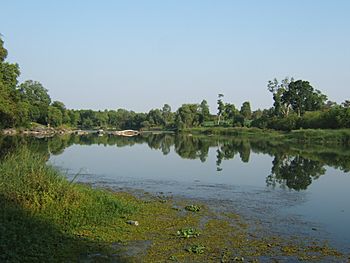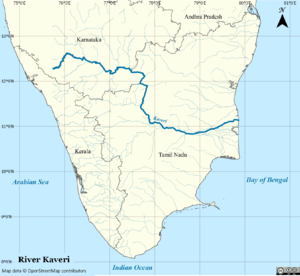Kaveri facts for kids
Quick facts for kids Kaveri |
|
|---|---|

Kaveri River flowing in Srirangapatna
|
|

Map of the Kaveri River basin
|
|
| Other name(s) | Cauvery |
| Country | India |
| States | Karnataka, Tamil Nadu, Kerala, Puducherry |
| Region | Southern India |
| Origin | Kodagu, Karnataka |
| Physical characteristics | |
| Main source | Talakaveri, Kodagu, Western Ghats, Karnataka Karnataka, India 1,341 m (4,400 ft) 12°23′N 75°29′E / 12.383°N 75.483°E |
| River mouth | Bay of Bengal Poompuhar, Tamil Nadu, India 0 m (0 ft) 11°21′40″N 79°49′46″E / 11.36111°N 79.82944°E |
| Length | 805 km (500 mi) |
| Discharge (location 2) |
(Period: 1998-2022)1,151.2 m3/s (40,650 cu ft/s)
|
| Basin features | |
| Basin size | 81,155 km2 (31,334 sq mi) |
| Tributaries | |
The Kaveri River, also called Cauvery, is one of the most important rivers in India. It flows through the states of Karnataka and Tamil Nadu. The Kaveri River starts at a place called Talakaveri in the Brahmagiri hills of the Western Ghats. This is in the Kodagu district of Karnataka.
The river begins about 1,341 meters (4,400 feet) above sea level. It flows for about 800 kilometers (500 miles) before reaching the Bay of Bengal at Poompuhar in the Mayiladuthurai district. The Kaveri is the third largest river in South India, after the Godavari and Krishna. It is the biggest river in Tamil Nadu, splitting the state into northern and southern parts. In old Tamil literature, the river was known as Ponni, which means "the golden mother." This name comes from the fine, golden silt the river leaves behind.
The Kaveri is a very special river for people in Southern India. They worship it as the Goddess Kaveriamma, or "Mother Cauvery." It is thought to be one of the seven holy rivers in India. The river is widely used for farming in both Karnataka and Tamil Nadu.
The area drained by the Kaveri River, called its basin, is about 81,155 square kilometers (31,334 square miles). Many smaller rivers, called tributaries, flow into the Kaveri. Some of these include the Harangi, Hemavati, Kabini, Bhavani, Lakshmana Tirtha, Noyyal, and Arkavati.
The river basin covers three states and one Union Territory:
- Tamil Nadu: 43,868 km² (16,937 mi²)
- Karnataka: 34,273 km² (13,233 mi²)
- Kerala: 2,866 km² (1,107 mi²)
- Puducherry: 148 km² (57 mi²)
In the Chamarajanagar district, the river forms an island called Shivanasamudra. Here, the beautiful Shivanasamudra Falls drop about 100 meters (330 feet). The Kaveri River is a vital source for watering farms and generating hydroelectric power. For centuries, it has helped ancient kingdoms and modern cities in Southern India to thrive. Because it is so important, there have been disagreements between Indian states over how to share its water. The river is highly respected in Hinduism and is often mentioned in old Tamil writings. The Kaveri River delta, where the river meets the sea, is a very crowded area. It is often hit by tropical cyclones from the Bay of Bengal.
Contents
What's in a Name?
The name Kaveri comes from different sources.
Dravidian Language
The name Kaveri comes from the Sankethi word for "river," which is kāviri. This is because the Kaveri is the main river for the Sankethi people who live along its banks. The name also comes from old Tamil words "ka" and "viri." These words mean "branching into fields or forests." This makes sense because the river splits into many smaller channels in its delta area.
Special Names for the River
The Kaveri River is also known as Daksina Ganga, which means "the Ganges of the South." When people worship it as a river goddess, they call it Kaveri Amman. As mentioned before, in ancient Tamil writings, it was also called Ponni, meaning "the golden maid," because of the golden silt it carries.
The River's Journey
The Kaveri River is a perennial river, meaning it flows all year round. It gets its water from monsoon rains.
It begins at Talakaveri in the Kodagu district of Karnataka. After leaving the Kodagu hills, the river flows onto the Deccan plateau. Here, it forms two islands: Srirangapatna and Shivanasamudra. At Shivanasamudra, the river drops 91 meters (300 feet) and creates the Shivanasamudra Falls. These are India's second largest waterfalls. The falls have two parts called Gagana Chukki and Bhara Chukki. After the falls, the river comes back together and flows through the Mekedatu gorge.
The Kaveri then enters Tamil Nadu through the Dharmapuri district. It winds its way until it reaches the Hogenakkal Falls. From there, it flows towards the town of Salem and enters the Stanley Reservoir in Mettur. The Mettur Dam was built here in 1934. After the reservoir, the Bhavani River, a major river that joins from the right, flows into the Kaveri.
Next, the river enters the Tiruchirappalli district. Here, it splits into two main parts. The northern part is called the Kollidam River (or Coleroon). The southern part keeps the name "Kaveri." After flowing for 16 kilometers (10 miles), the two rivers meet again and form the Srirangam Island. From there, the river branches off into 36 different channels. The Kaveri travels a total of 765 kilometers (475 miles) before it finally empties into the Bay of Bengal.
How Much Water Flows?
The amount of water flowing in the Kaveri River changes throughout the year. For example, at the Grand Anicut dam, the average flow of water between 1998 and 2022 was about 1,151 cubic meters per second. At the Lower Anicut, the average flow was about 928 cubic meters per second during the same period. The flow is highest during the monsoon season and lowest during dry periods.
Rivers Joining Kaveri
The Kaveri River has 29 main tributaries. Some of the most important ones are:
- Harangi
- Hemavati
- Lakshmana Tirtha
- Kabini
- Suvarnavathi
- Shimsha
- Arkavati
- Sarabanga
- Bhavani
- Noyyal
- Thirumanimutharu
- Amaravati
Nature and Wildlife
The area around the Kaveri River, especially in Karnataka, has two main types of natural zones: forests and farming areas. More than half of the basin is used for growing crops, with rice and sugarcane being the most common.
The Kaveri basin is home to many different plants. Some of the main tree species found here include Terminalia arjuna, Tamarindus indica (Tamarind), Pongamia pinnata, Salix tetrasperma (Willow), Ficus benghalensis (Banyan), Ficus religiosa (Peepal), Eucalyptus torticornis, and Diospyros montana.
The Ranganathittu Bird Sanctuary is located on the Kaveri River. This special area is protected and supports many bird species. You can see birds like the painted stork (Mycteria leucocephala), spot-billed pelican (Pelecanus philippensis), and black-headed ibis (Threskiornis melanocephalus). The sanctuary is also home to animals like the mugger crocodile (Crocodylus palustris), smooth-coated otter (Lutrogale perspicillata), and a special type of fish called the hump-backed mahseer (Tor remadevii).
Religious Stories
In Hinduism, the Kaveri River is one of the seven holy rivers in India. There are many old stories, called Puranas, that tell about how the Kaveri became a river and a goddess.
One story from the Skanda Purana says that during a great event called the Samudra Manthana (the churning of the Ocean of Milk), two divine beings, Mohini and Lopamudra, brought out the nectar of immortality for the gods. Later, Mohini became a cave in the Brahmagiri hills. The god Brahma raised Lopamudra as his daughter. King Kavera, who had no children, was very devoted to Brahma. Brahma was pleased and offered Lopamudra to King Kavera. Lopamudra was then renamed Kaveri. When Kaveri grew up, she prayed to Brahma to turn her into a river that could purify people.
Another legend tells that Lopamudra became the wife of a wise man named Agastya. During a severe drought in South India, she took the form of water. Sage Agastya carried her in his small brass water pot as he traveled south. When he stopped on a hill, he placed the pot on the ground. But then, Ganesha, disguised as a crow, knocked the water pot over. The spilled water flowed down the hill, bringing life to the dry land.
How Kaveri Helps People
The Kaveri River is mainly used for three important things:
- Providing water for farming (irrigation).
- Supplying water for homes and cities.
- Generating electricity.
A long time ago, it was estimated that the Kaveri River had a total flow of about 12 million acre-feet of water. About 60% of this water was used for irrigation.
A pump station at Torekadanahalli sends 540 million liters (19 million cubic feet) of water from the Kaveri River every day to the city of Bangalore, which is about 100 kilometers (62 miles) away.
The first hydroelectric power plant in Asia was built on the left side of the Sivanasamudra Falls on the Kaveri River in 1902.
The Krishna Raja Sagara Dam can hold 49 thousand million cubic feet (tmc ft) of water. The Mettur Dam, which creates the Stanley Reservoir, can hold 93.4 tmc ft of water.
In August 2003, the amount of water flowing into reservoirs in Karnataka was the lowest in 29 years. There was a 58% shortage of water. The Krishna Raja Sagara dam had only 4.6 tmc ft of water stored.
In February 2020, the Tamil Nadu assembly passed a law to declare the Kaveri Delta a Protected Agricultural Zone. This includes areas like Thanjavur, Thirvarur, Nagapattinam, and parts of Cuddalore and Pudukottai.
Sharing the Water
There has been a long-standing disagreement over how to share the Kaveri River's water. This dispute started in 1807 when the Madras Government disagreed with Mysore State's plans for new irrigation projects. After many discussions, an agreement called the General Agreement of 1892 was made.
On February 16, 2018, the Supreme Court of India made a decision on the water sharing. It said that:
- Karnataka would get 284.75 tmc ft of water.
- Tamil Nadu would get 404.25 tmc ft.
- Kerala would get 30 tmc ft.
- Puducherry would get 7 tmc ft.
- 10 tmc ft would be set aside for protecting the environment.
- 4 tmc ft would be set aside for water that is lost and cannot be avoided.
Following the Supreme Court's order, the Indian government created the Cauvery Water Management Authority (CWMA) on June 1, 2018. This group was formed to help manage the water sharing dispute among Tamil Nadu, Karnataka, Kerala, and Puducherry. The government was supposed to form this authority within six weeks of the court's decision.
On June 22, 2018, the Central government also set up the Cauvery Water Regulation Committee (CWRC). This was done despite some opposition from Karnataka, and it followed the rules set by the Supreme Court for managing the Kaveri.
See also
 In Spanish: Río Kaveri para niños
In Spanish: Río Kaveri para niños
- List of rivers of India
- Kaveri Pushkaram


